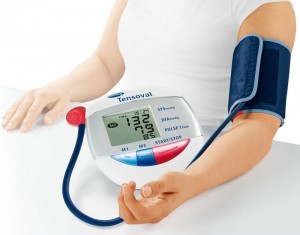Ever go to the doctor’s office for a routine check-up and you get your blood pressure taken and the number is higher than normal? Ever wonder what is being measured? Or why that arm cuff squeezes you so hard? Or how you can check your blood pressure yourself at home?
These guidelines and tips will answer all of these questions and more about the basics of blood pressure.
What is Blood Pressure?
Blood pressure is the amount of force exerted through the arteries in the body every time your heart beats. This pressure can change with body positions, sleep, eat, stress or exercise. It is recorded using two numbers. The systolic or top number is the pressure present in the arteries when the heart beats or contracts. The diastolic or bottom number is the pressure in the arteries as the heart rests between beats.
According to the American Heart Association, it is recommended that a healthy reading for the systolic number is less than 120 and for diastolic, less than 80. Any reading over that range is at a risk of being hypertensive, or having high blood pressure.
Having high blood pressure or hypertension, is detrimental to the well being of your life. Too high of a number can increase the risk of coronary artery disease, heart attack or stroke, kidney failure or even heart failure. It damages and scars your arteries and hinders the tissues in your body from getting the oxygen it needs via blood.
When the blood vessels are too weak to pump the needed blood throughout themselves and out to the body, the heart then compensates by pumping harder. Over time this results in great damage to the heart.
This is why staying active and eating healthy is important. Also having regular check ups are important because your family history can reveal that you could possibly develop hypertension from hereditary factors.
How to properly choose your blood pressure monitor.
The first step to getting an accurate reading is picking the right monitor. Many people are familiar with seeing the cuff with the gauge and pump attached to it and the stethoscope used to record blood pressure; but there is an easier way to do this.
Automatic blood pressure monitors are machines that do the same thing the doctor or nurse does manually. They are just faster and more user friendly with just the push of one button to get your reading.
The cuff squeezes the arm enough to get a strong pulse to measure and from there the machine calculates the strength of that pulse to get the reading.
Finger and wrist monitors are not recommended because the reading is not as accurate or reliable. Automatic ones with a upper arm cuff are effective.
When getting the automatic monitor make sure that the cuff fits the arm of the person needing it. A cuff that does not fit properly will yield in an inaccurate reading.
There are a lot of monitors out there to choose from. Make sure that your monitor has been validated and approved by the following three:
- Association for he Advancement of Medical Instrumentation
- The British Hypertension Society
- The International Protocol for the Validation of Automated BP Measuring Devices
For a list of monitors that have been validated visit the Dabl Educational Trust website.
Steps to getting an accurate reading at home.
- Make sure the cuff fits.
- It should fit around the upper arm, right above the elbow.
- Be still.
- Moving around while getting your blood pressure checked will skew the reading. Also don’t exercise, drink caffeinated beverages or smoke 30 minutes prior to measuring.
- Sit Correctly where good posture is achievable (i.e, at the kitchen table.)
- Being slouched over or having your feet crossed can change the reading as well. Your feet should be flat on the floor and arm resting on a flat surface.
- Take blood pressure at the same time everyday.
- Record either always at night or in the morning.
- Take readings a couple times.
- Do them a minute apart and record for a more solid result.
- Understand the numbers.
- Remember less than 120/80 mm Hg is optimal.
- Consult with your doctor.
- Home monitoring should NOT replace visiting your doctor. Share your home readings with your doctor to make sure everything is alright.



